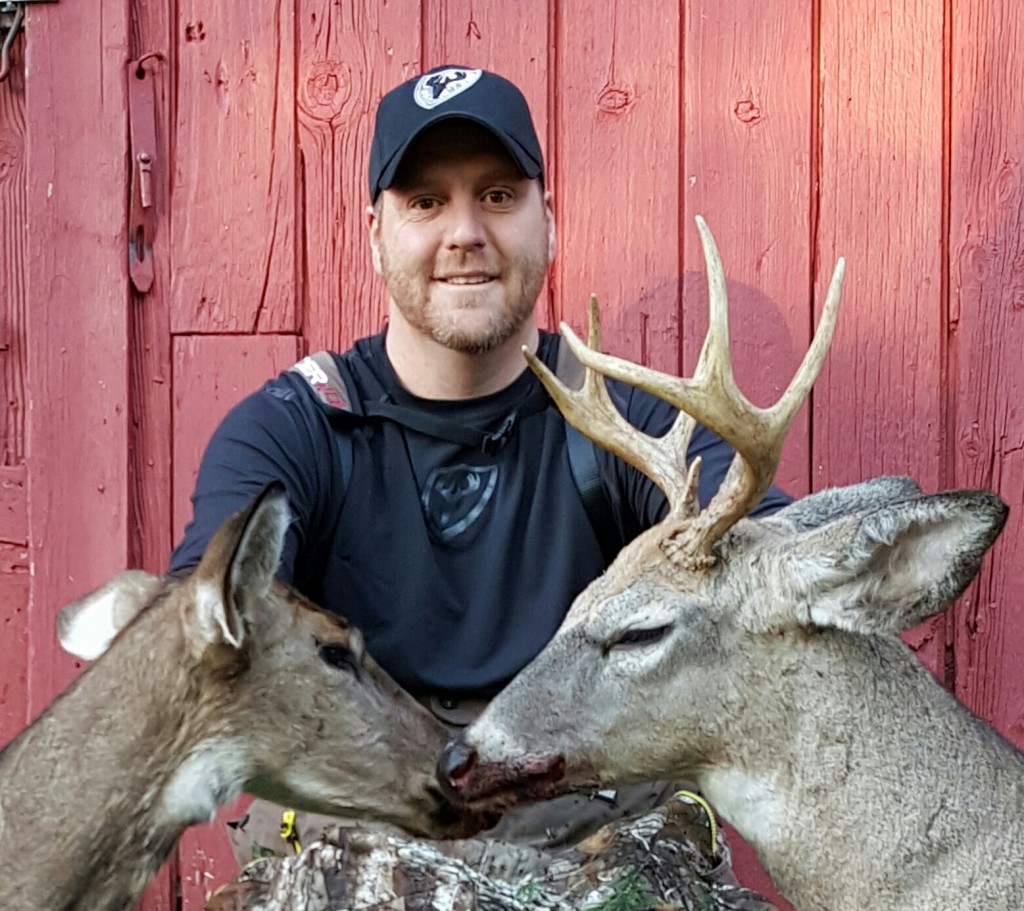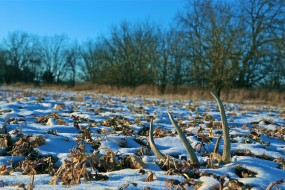
Nose to the air, with a face full of my apple flavored DUI, the lead doe carelessly entered my foodplot. Minutes later she lay dead not 60 yards away, having fallen prey to a well placed heart shot arrow. After a few celebratory texts, and also checking the score of the Michigan vs. Michigan State football game, I heard more noise in the woods.
This time the buck chose a different path to enter the plot, because his priorities were different. He scent checked the entire field, noticing the dead doe who wasn’t in heat, and then committed to dinner. I double lunged him less than 20 minutes after I had shot the doe. The date was Oct. 18 and I had two mature deer dead well before sundown.
By Jason Hebert
I’m hooked on my “poor man’s food plots” for several reasons. First they’re cheap in terms of money and time invested. Second, I can plant them just about anywhere. Lastly, if designed properly, they are deer magnets. When discussing food plots, I like to think of them in two different ways. Feeding plots are big and help supplement the local herd’s nutritional needs. Most of the deer feed in these near or after dark. I do not hunt feeding plots. Killing plots are small, and deer feel comfortable feeding in these during shooting hours. I do hunt killing plots.
When creating a food plot I always consider two things. First, am I going to hunt it? And second, if so, how am I going to access it? Also, what wind do I need? This in itself is a entirely different topic, but always consider these questions before selecting a location for your food plot. There’s no sense making a sweet killing plot that I can’t hunt. Or a feeding plot that I can’t walk by without bumping all of the deer out of it.
First on the list is considering safety. I depend on Bug Blocker sprays to protect my family from insect borne illnesses that seem to be on the rise, and enjoy the spring and summer months outdoors. I’ll spray all of my ScentBlocker Recon Shirt and Pant or Featherlite work gear with Bug Blocker for Ticks, and douse myself with the mosquito spray before embarking on any summer work project.

Mow, Kill and Grow
My first style of poor man’s plot is what I call the mow-n-grow.I find a likely area and clear it of any brush and trees. Then, I get in with an old push mower past its prime and knock down vegetation to a more manageable height. About two weeks later, I wait until what has regrown and “greened up” to return with a highly concentrated mixture of weed killer in my pump sprayer. It’s important to check the weather forecast to make sure it won’t rain anytime soon. The weed killer needs a certain amount of time to be absorbed and become effective. After saturating all of the weeds and such, I leave to return again in two weeks.
When I return, I bring the appropriate amount of seed to plant the desired area. I usually do this sometime between July and August and am then planting turnips, canola, forage radish, and possibly oats.
The food plot offerings will depend on the time of year. If the weeds are good and dead, I’ll simply hand spread the seed by throwing it, or by using a small seed broadcaster. Ideally I seed the plot before a rain storm. The dried, dead weeds act as a mulch, and the rains not only help germinate the seed, but they knock it down to the ground for the desired seed to soil contact. If the weeds are not quite dead yet, I’ll re-spray and return in another two weeks to seed. Whitetail Institute has developed three products, Secret Spot, BowStand and No-Plow that are all designed specifically for these type plots.

Corn, Beans and Greens
The second poor man’s food plot idea I like to use involves either a late summer standing corn or bean field. In this one, I only use turnips and radish. Three excellent products for this situation are Whitetail Institutes, Tall Tine Tubers, Winter-Greens and No-Plow. With farmer or landowner permission, I simply walk around in the rows where I want my plot to grow and spread the tiny seeds on the exposed soil.
The fields are generally weed free and irrigated. As the corn and beans dry, the sunlight hits the soil and helps the turnips and radish grow. Once the field is picked, I have a beautifully manicured food plot in place. After the first frosts of fall, the starches in their leaves turn to sugars. The deer hammer the greens all fall, and dig for the rest of the plant in the winter. The turnips and radish have no effect on the combines at all, and a few will get run over but it’s no big deal.
And, The Easiest One!
The last, and simplest plot I do requires a bit of fertilizer and that’s it. I will find potential treestand or feeding areas and fertilize them. Yep, it’s that simple, I fertilize the native weeds.

Deer know where their food is the healthiest and will easily find these areas. Their nutrient rich weeds will become preferred food sources. The results are impressive. I like to use a bag of 12-12-12 fertilizer mix from my local Home Depot. I prefer to fertilize them in the spring and summer, but sometimes wait for the fertilizer to go on clearance in late spring.
Once my plots are growing well and it is nearing the fall, I start to monitor them. By going into complete scent free mode, the deer have no reason for alarm as I maintain my summer trail camera routine.
I’ll put out my cameras in easy to access places, and begin to condition the local deer with DUI – Deer Under the Influence attractant spray. The DUI sprays are habit forming and deer love them. I’ll spray a bit each time to check a camera, and soon after the deer will curiously arrive for a sniff, and a picture.
Eventually the deer form the habit of checking the spot in front of the camera each day or night. If I set everything up properly, I have a huntable treestand nearby. If not I quickly figure out where to hang one.
That’s it … short, sweet and simple. Get out this year and try a poor man’s plot. You don’t need to spend a lot of money creating an effective food plot. As always, be safe and have fun.
+++++
Maximize Your Deer Season Planning
 From Deer & Deer Hunting Magazine, the 2016 Whitetails Wall Calendar features the work of deer researchers Wayne Laroche and Charlie Alsheimer, who reveal the 2016 whitetail rut prediction, based on years of lunar cycle research. Utilize this deer moon phase calendar to find out which days the deer will be seeking and chasing so you can time the rut for the best time to hunt.
From Deer & Deer Hunting Magazine, the 2016 Whitetails Wall Calendar features the work of deer researchers Wayne Laroche and Charlie Alsheimer, who reveal the 2016 whitetail rut prediction, based on years of lunar cycle research. Utilize this deer moon phase calendar to find out which days the deer will be seeking and chasing so you can time the rut for the best time to hunt.
Get your calendars today for home, work and deer camp!

